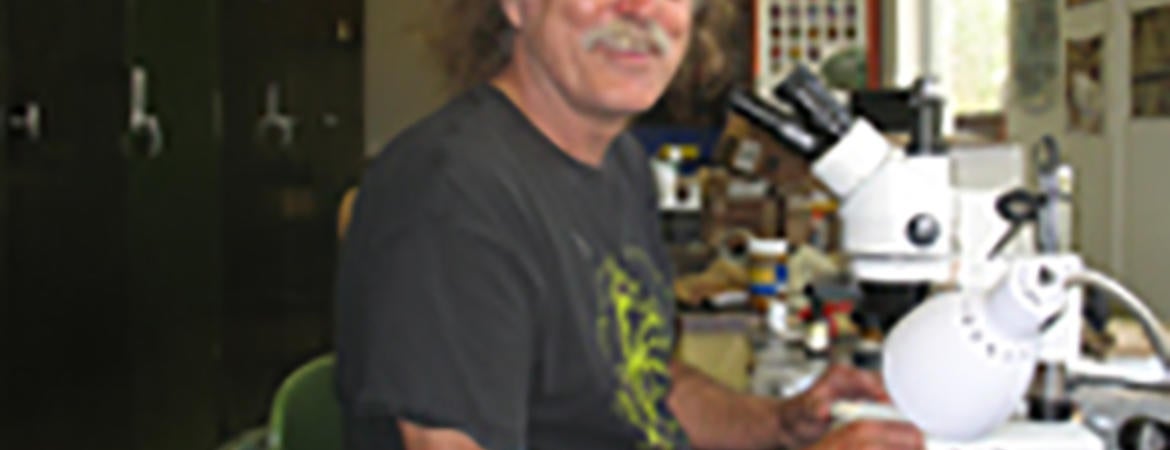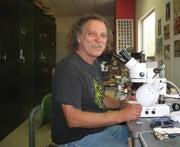
Charles Darwin was an amateur. Like most of the people practicing science at the time, Darwin had no official position, no job, no doctorate, and no government grants. He did his work on his own time, funded by his private income.
It would seem impossible for such an amateur to exist today, or to make the kind of world-changing discoveries that professional scientists make. Yet Kerry Knudsen, at the University of California, Riverside, fits right into Darwin’s model, even if he got started a little later than the famous biologist.
Knudsen has no degrees, and doesn’t get paid for his work at UCR. But over the last 14 years, he has turned himself from a construction worker on disability into one of the world’s leading authorities on lichens. There aren’t that many in the world, he says, “and I’m the only lichenologist in California.”
Forced to retire from the construction industry because of a blood-clot disorder, Knudsen planned to go to college and earn a bachelor’s and then a doctorate in botany. But he was turned down by the California Department of Rehabilitation for educational financing. One day, he said, he decided to go out his back door and “whatever was growing there, that’s what I’ll study.” The first organism he came across was a lichen.
Lichens are unusual organisms, a symbiotic composite of a fungus and a photosynthetic partner, usually an algae or a cyanobacterium. They can be found in the most varied places – deserts, arctic tundra, rain forests, rock formations, roofs of houses. Yet they can be extremely sensitive to smog and pollution, and form a “canary in the mine” for Southern California.
“There are 1,500 lichen species in California,” said Knudsen, 15,000 worldwide, “and we’re losing species faster than we’re describing them. We need taxonomists to describe what’s there.” Taxonomy, he said, is the study of new species, the study of diversity, and it is in this area that Knudsen has made his reputation. In the world of lichenology, he is famous.
His most well-known new species has been Coloplaca obamae. “I was writing the paper [describing the species] while Obama was giving his acceptance speech,” said Knudsen. “I named it because of his support for scientific projects.”
Knudsen has written more than 170 scientific papers, has described more than 50 new lichen species, and has had 4 species named for him. He receives requests for his expertise from all over the world. He began at his kitchen table, but soon it was suggested that he associate himself with a university, so in 2003 he came to UCR’s Herbarium and volunteered. Andy Sanders, the Herbarium’s director, was thrilled. “He had about 200 lichens someone had given him,” said Knudsen, “and was hoping I would build a collection for him.” Today that collection numbers 17,000 specimens.
Now, after 14 years, Knudsen will finally be earning a paycheck as a lichenologist. This fall he takes up an academic appointment at the Czech University of Life Sciences in Prague, with a worker’s visa, health insurance, and a salary. He will be joining his wife, Jana Kocourkova, also a lichenologist at the Czech university. They have known each other for seven years and been married for two, giving new meaning to the phrase “long-distance relationship.” Knudsen will be working with scientists from Turkey, Sweden, Italy, and China on the Acarosporaceae family of lichens, on which he is the acknowledged world’s expert. He expects to live in the Czech Republic most of the time, but will return to California, and UCR, some portion of each year.
Twenty years ago, Knudsen says, “I never would have imagined my life would turn out like this. Lichens have been good to me.”
